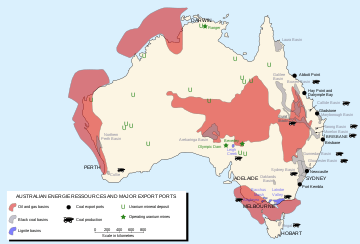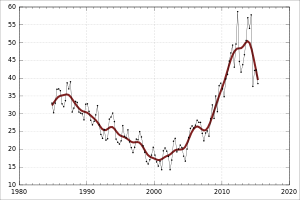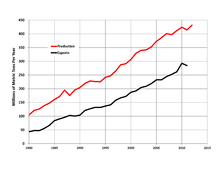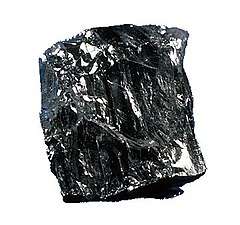Coal in Australia
Coal is mined in every state of Australia. The largest black coal resources occur mainly in Queensland and New South Wales.[1] About 70% of coal mined in Australia is exported, mostly to eastern Asia,[2] and of the balance most is used in electricity generation. Coal production in Australia increased 13.6% between 2005 and 2010 and 5.3% between 2009 and 2010.[3] In 2016, Australia was the biggest net exporter of coal, with 32% of global exports (389 Mt out of 1,213 Mt total), and was the fourth-highest producer with 6.9% of global production (503 Mt out of 7,269 Mt total). 77% of production was exported (389 Mt out of 503 Mt total).[4]



Coal mining in Australia has been criticized by members of the environmental movement,[5][6] due to carbon dioxide emissions during combustion. This criticism is primarily directed at thermal coal, for its connection to coal-fired power stations as a major source of carbon dioxide emissions, and the link to climate change and the effects of global warming on Australia.[7] The burning of coal for electricity produces 29% of Australia's total greenhouse gas emissions, based on 2013-2014 Clean Energy Regulator data.[8]
The Carbon Pollution Reduction Scheme, which followed the draft report in the Garnaut Climate Change Review, placed a price on carbon emissions through a reducing cap and trade emissions trading scheme and incentivised against carbon pollution temporarily, before it was revoked from 1 July 2014 onwards.
Forms of coal
Australian coal is either high-quality bituminous coal (black coal) or lower-quality lignite (brown coal).[9]
Bituminous coal is mined in Queensland and New South Wales, and is used for both domestic power generation and for export. It is mined underground or open-cut before being transported by rail to power stations or export shipping terminals.[10][11] Bituminous coal was also once transported to other Australian states for power generation and industrial boilers.
Lignite is mined in Victoria and South Australia,[12] and is of lower quality due to a lower thermal value largely caused by a high water content.[13] Ash content varies significantly but some Australian lignite have relatively low ash content.[14] As a result, Victoria adopted German power station and briquette technology in the 1920s to utilise the lignite reserves of the Latrobe Valley. In 2013 coal from three open cut lignite coal mines in Victoria is used for baseload power generation.[12]
History
Australian coal was first discovered in New South Wales by shipwreck survivors in August 1797, at Coalcliff, north of Wollongong. George Bass discovered coal soon after in the cliffs at Newcastle off of Point Solander.[15][16]
Production, exports and reserves

In 2008/09, 487 million tonnes of coal was mined, and 261 million tonnes was exported.[17]
In 2009, Australia was the fourth-highest coal producer in the world, producing 335 megatonnes (Mt) of anthracite and 64 Mt of lignite.[18] Australia was the biggest anthracite exporter, with 31% of global exports (262 Mt out of 836 Mt total). 78% of 2009 anthracite production was exported (262 Mt out of 335 Mt total). Australia's global anthracite export share was 14% of all production (836 Mt out of 5,990 Mt total).[19]
In 2011, coal exports were Australia's second-largest source of export income, after iron ore exports.[20] In 2011, coal exports were worth A$47 billion Australian dollars, or US$47.8 billion, with US$15.6 billion coming from exports of thermal coal for power stations.[20] Coking coal generated A$22.4 billion of export revenue in 2012/13 financial year with thermal coal bringing in A$16.1 billion during the same period.[21]
According to the Australian Bureau of Agricultural and Resource Economics and Sciences in 2011 the economically demonstrated reserves to production ratios for bituminous coal and lignite in Australia are 111 years and 539 years respectively. However, these figures do not account for growth in production.[22] Bituminous coal exports from Australia have been growing at a rate of 5% (on average during the last 20 years). If this rate of growth would-be maintained to extinction all current economically demonstrated black coal in the country would be depleted in under 40 years. However, continued growth at that rate is unlikely to occur for such a long period, and this estimate does not reflect growth in the demonstrated resource. Explorations in the last decade has resulted in a significant increase in inferred coal resources which are now almost double the economically demonstrated resource.[23]
In 2010–11, Australia was the fifth largest producer of coal, and by proportion exported, and was the second largest exporter of coal in the world,[24] with most of the exports going to Japan. Total production of bituminous coal in Australia was 405 million tonnes (Mt.), down from 471 Mt. in 2009–10. The drop was largely as a result of the Queensland floods of January 2011 where production declined from an expected 200 Mt. to 163 Mt.[25]
In 2013/14, 430.9 million tonnes of coal was mined, of which 375.1 million tonnes was exported.[26] Coal provides fuel for about 69% of electricity production in Australia.[24] The Latrobe Valley in Victoria produced 98.5% of Australia's total brown coal production of 57.8 Mt, down from 66.7 Mt in 2001–2, none of which was exported.
In 2013, Australia was the world's fifth-largest coal producer, after China, the United States, India, and Indonesia. However, in terms of proportion of production exported, Australia was the world's second largest coal exporter, with exports accounting for roughly 73% of coal production. Indonesia exports about 87% of its coal production.[24]
In 2016, Australia was the biggest net exporter of coal, with 32% of global exports (389 Mt out of 1,213 Mt total). It was still the fourth-highest producer with 6.9% of global production (503 Mt out of 7,269 Mt total). 77% of production was exported (389 Mt out of 503 Mt total).[4]
Major mines
The following table lists the major Australian Coal mines.[27]
| Mine | State | Location | Ultimate owner | Coordinates | Type of coal | Million tons mined pa | Million tons exported pa | Major buyers | Major method |
|---|---|---|---|---|---|---|---|---|---|
| Anglesea | VIC | Anglesea | Alcoa of Australia | 38°23′42″S 144°09′58″E | Lignite | ? | nil | Anglesea Power Station | Open Cut |
| Beltana | NSW | Singleton | Xstrata | 32°39′22″S 151°07′16″E | Thermal | 7.6 | ? | ? | Underground |
| Bengalla | NSW | Muswellbrook | Coal and Allied | 32°19′24″S 150°51′29″E | Thermal | ? | ? | ? | Open Cut |
| Callide | QLD | Callide (Biloela) | Batchfire | 24°19′38″S 150°37′04″E | Thermal | 8.5 | ? | ? | Open Cut |
| Capcoal | QLD | Middlemount | Anglo American | 22°57′50″S 148°33′00″E | Hard Coking Coal & PCI | 7 | ? | ? | Open Cut & Underground |
| Dawson | QLD | Dawson (Moura) | Anglo Coal | 24°17′46″S 151°06′47″E | Soft Coking & Thermal | 7 | ? | ? | Open Cut |
| Drayton | NSW | Hunter Valley | Anglo Coal | 32°20′46″S 150°54′40″E | Soft Coking & Thermal | 7 | ? | ? | Open Cut |
| Duania | QLD | Moranbah | BMA | 22°02′34″S 148°17′21″E | Hard Coking Coal & PCI | 4 | ? | ? | Open Cut |
| Broadmeadows | QLD | Moranbah | BMA | 21°44′35″S 147°58′15″E | Hard Coking Coal | 4 | ? | ? | Underground |
| Blackwater | QLD | Blackwater | BMA | 23°42′36″S 147°33′00″E | Thermal/Coking | 13 | ? | ? | Open Cut |
| Blair Athol | QLD | Clermont | TerraCom[28] | 22°41′28″S 147°31′59″E | Thermal | 2.7 | ? | ? | Open Cut |
| Bulga Coal | NSW | Singleton | Oakbridge Group (Managed by Xstrata Coal) | 32°39′S 151°04′E | Thermal/Coking | 10.8 | all | Japan, Nippon Steel, Nippon Oil | Open Cut |
| Burton | QLD | Nebo | Peabody Energy Australia | 21°34′12″S 148°10′59″E | Thermal/Coking | 4 | ? | ? | Open Cut |
| Collinsville | QLD | Collinsville | Xstrata | 20°29′31″S 147°47′02″E | Thermal/Coking | 5 | ? | ? | Open Cut |
| Coppabella | QLD | Coppabella | Peabody Energy Australia | 21°50′56″S 148°25′59″E | ? | 7 | ? | ? | Open Cut |
| Curragh | QLD | Blackwater | Wesfarmers | 23°28′30″S 148°51′43″E | Thermal/Coking | 7 | ? | ? | Open Cut |
| Goonyella/Riverside | QLD | Moranbah | BMA | 21°43′48″S 147°58′44″E | Hard Coking Coal | 11 | ? | ? | Open Cut/Underground |
| Griffin Coal | WA | Collie | LANCO Infratech | 33°21′32″S 116°09′11″E | Bituminous | 5 | nil | Bluewaters Power, Synergy Power | Open Cut |
| Grosvenor Mine | QLD | Moranbah | Anglo American | 21°58′31″S 148°00′36″E | Hard Coaking Coal | ? | ? | ? | Underground |
| Hail Creek | QLD | Nebo | Glencore | 21°29′06″S 148°22′05″E | Hard Coking Coal | 4.5 | all | ? | Open Cut |
| Jellinbah | QLD | Bluff | Jellinbah Group | 23°30′15″S 148°52′59″E | PCI and Soft Coking | 4.6 | 4.6 | Various steelmakers - Japan, China, India and Brazil | Open Cut |
| Lake Vermont | QLD | Dysart | Jellinbah Group | 22°26′58″S 148°25′21″E | Hard Coking Coal and PCI | 8.0 | 8.0 | Various steelmakers - Japan, China, India and Brazil | Open Cut |
| Loy Yang | VIC | Traralgon | Loy Yang Power | 38°15′07″S 146°34′26″E | Lignite | ? | nil | Loy Yang Power Station | Open Cut |
| Moorvale | QLD | Moranbah | Peabody Energy Australia | 21°59′24″S 148°21′14″E | Thermal/PCI | ? | ? | ? | Open Cut |
| Mount Arthur Coal (MAC) | NSW | Muswellbrook | BHP Billiton | 32°20′01″S 151°52′36″E | Thermal | 15 | 12 | ? | Open Cut |
| Mount Thorley Warkworth (MTW) | NSW | Singleton | Coal & Allied | 32°37′30″S 151°05′24″E | Thermal/Coking | ? | ? | ? | Open Cut |
| Moranbah North | QLD | Moranbah | Anglo American | 21°52′26″S 147°57′50″E | Hard Coking Coal | 4.5 | ? | ? | Underground |
| Morwell | VIC | Morwell | Engie Energy International | 38°16′22″S 146°23′30″E | Lignite | 20 | nil | Hazelwood Power Station, Energy Brix | Open Cut |
| Norwich Park | QLD | Dysart | BMA | 22°46′48″S 148°28′48″E | Soft Coking Coal | 6 | all | ? | Open Cut |
| Newlands | QLD | Glenden | Xstrata | 21°12′43″S 147°53′24″E | Thermal/Coking | 12 | ? | ? | Open Cut & Underground |
| Peak Downs | QLD | Moranbah | BMA | 22°14′13″S 148°00′43″E | Hard Coking Coal | 13 | all | ? | Open Cut |
| Poitrel | QLD | Moranbah | BMC | 22°02′50″S 148°15′06″E | Hard Coking Coal & PCI | 4 | ? | ? | Open Cut |
| Saraji | QLD | Dysart | BMA | 22°21′43″S 148°17′24″E | Hard Coking Coal | 7.5 | all | ? | Open Cut |
| South Walker Creek | QLD | Moranbah | BMC | 21°44′51″S 148°26′03″E | Hard Coking Coal & PCI | 5 | ? | ? | Open Cut |
| Ulan | NSW | Ulan via Mudgee | Xstrata | 32°14′38″S 149°44′56″E | Thermal | 5 | ? | ? | Open Cut & Underground |
| Wesfarmers Premier Coal | WA | Collie | Wesfarmers | 33°24′40″S 116°14′20″E | Bituminous | 3.5 | nil | Synergy Power | Open Cut |
| Yallourn | VIC | Yallourn | EnergyAustralia | 38°10′42″S 146°20′21″E | Lignite | ? | nil | Yallourn Power Station | Open Cut |
Major export markets for Australian coal
| Country/Area | Million Tons Coking | Million Tons Steaming | Million Tons Total | Rank | % of exports |
|---|---|---|---|---|---|
| Japan | 42.0 | 77.7 | 119.7 | 1 | 30.9 |
| China | 46.3 | 47.1 | 93.4 | 2 | 24.1 |
| Korea (ROK) | 20.4 | 34.4 | 54.8 | 3 | 14.1 |
| India | 40.1 | 6.7 | 46.8 | 4 | 12.1 |
| Other | 28.2 | 14.5 | 42.7 | 5 | 11.0 |
| Taiwan | 9.4 | 20.5 | 29.9 | 6 | 7.7 |
Major coal export ports
The Port of Newcastle, New South Wales, is the world's largest and most efficient coal handling operation through its two terminals: Carrington and Kooragang. Australia has nine major coal-export ports,[30] including:
| Port | State | Million Tons 2009 |
Million Tons 2008 |
|---|---|---|---|
| Newcastle[31] | NSW | 92.8 | 91.4 |
| Hay Point[32] | QLD | 82.4 | 80.4 |
| Gladstone[33] | QLD | 56.2 | 54.1 |
| Abbot Point[32] | QLD | 14.4 | 12.5 |
| Port Kembla[34] | NSW | 13.7 | 13.3 |
| Brisbane[33] | QLD | 6.3 | 5.5 |
| Total | 265.8 | 257.2 |
Major coal mining companies
Environmental impacts
.jpg)
The Australian community is understandably concerned about any mining activity that could place private or public property or valuable landscapes at risk.[35] The coal industry claims however that extensive rehabilitation of areas mined helps to ensure that land capability, after coal mining, meets agreed and appropriate standards.[36]
Coal is the principal fossil fuel used in power generation not only in Australia but in many other countries. Links between coal mining, coal burning, and climate change are being discussed widely in Australia.[37][38]
On 27 November 2006 the Land and Environment Court of New South Wales judge Justice Nicola Pain made the decision to set aside the Director-General's acceptance of the Environmental Assessment for the Anvil Hill coal mine,[39] on the grounds that it did not include a comprehensive greenhouse gas assessment, even though the proposed mining of coal was for export. However, on 7 June 2007 the planning minister for NSW Frank Sartor reversed this decision and approved the mine, attaching a list of 80 conditions to the mines operation including conservation offsets.[40]
Environmental regulation of coal mining
Commonwealth law
The main Commonwealth environmental laws potentially applicable to coal mining are the Environment Protection and Biodiversity Conservation Act 1999 (EPBC Act) and the Clean Energy Act 2011. The EPBC Act is triggered if a proposed action is likely to have a significant impact on a matter of national environmental significance, for example federally listed threatened species.
State laws
New South Wales
Relevant laws are mining law, land use planning law, biodiversity law and water law.
Pollution law
Coal mining requires a pollution control ('environment protection') licence under the Protection of the Environment Operations Act 1997 (NSW) if it exceeds the following thresholds set out in Schedule 1 of the Act: if it is mining, processing or handling of coal (including tailings and chitter) at underground mines or open cut mines and (a) it has a capacity to produce more than 500 tonnes of coal per day, or (b) it has disturbed, is disturbing or will disturb a total surface area of more than 4 hectares of land by: (i) clearing or excavating, or (ii) constructing dams, ponds, drains, roads, railways or conveyors, or (iii) storing or depositing overburden or coal (including tailings and chitter).[41]
Queensland
In March, 2020, the Queensland Resources Council introduced safety protocols to promote the health of coal mine workers amidst the international spread of COVID-19. These included improvements to social distancing of workers, disallowing visitors from the public to enter the sites and checking the temperature of workers at mine site entries.[42]
Clean coal technologies
The Federal Government has, as part of its pledge to mitigate global warming,[43] committed A$100 million to commission a climate change-fighting "clean coal" and carbon sequestration research institute to make Australia a leader in this emerging technology. As of 2014 carbon sequestration technology was not expected to be commercially viable for at least 5 to 10 years,[44] but the Federal Labor government argues that it is a vital technology given Australia's reliance on coal-fired electricity.[45] The merits of "clean coal" have been highly disputed by some technical experts[46] and environment awareness groups.[47]
See also
- Carbon capture and storage in Australia
- Coal companies of Australia
- Coal phase out
- Greenhouse Mafia
- Hunter Valley Coal Chain
- List of coal fired power stations in Australia
- Mining in Australia
- Mitigation of global warming in Australia
- Coastal coal-carrying trade of New South Wales
References
- "Coal". Australian government Geoscience Australia. Retrieved 27 March 2020.
- "Coal". Government of South Australia Energy Mining. March 2020. Retrieved 27 March 2020.
- IEA Key World Energy Statistics 2011 October 2011
- IEA Key World Energy Statistics 2017 (PDF). International Energy Agency. 2017. p. 17. Archived (PDF) from the original on 7 July 2018.
- The Greens NSW (July 2011), "Coal and Coal Seam Gas Policy". Archived from the original on 5 February 2014. Retrieved 15 June 2020.
- Greens Queensland. (13 April 2010). Upper Hunter Valley coal mining shows dangers for Queensland Archived 16 March 2015 at the Wayback Machine. Media Release. Retrieved 23 January 2013.
- Preston, B.L. and Jones, R.N Climate Change Impacts on Australia and the Benefits of Early Action to Reduce Global Greenhouse Gas Emissions Archived 25 February 2009 at the Wayback Machine. CSIRO. Retrieved 23 January 2013.
- "Is 'clean coal' power the answer to Australia's emissions targets?". 25 January 2017. Retrieved 3 February 2017.
- "Coal". Data & Publications. Australian Government. Archived from the original on 4 January 2019. Retrieved 9 May 2019.
- "Coal Geology". Science Topics. Australian Government. Archived from the original on 25 July 2019. Retrieved 15 August 2019.
- "Coal transport infrastructure development". Queensland Government. 24 August 2017. Archived from the original on 1 April 2019. Retrieved 15 August 2019.
- Geoscience Australia (2013). "Coal - Geoscience Australia". Australia's Mineral Resource Assessment 2013. Australian Government. Archived from the original on 1 March 2018. Retrieved 18 September 2018.
- "Lignite/ Brown Coal". Victoria State Governmant. Department of Jobs, Precincts and Regions, Victoria, Australia. 4 March 2016. Archived from the original on 6 July 2018. Retrieved 8 January 2019.
...its high moisture content - which ranges from 48-70 per cent - reduces its effective energy content
- Durie, R. "THE CHARACTERISTICS OF AUSTRALIAN COALS AND THEIR IMPLICATIONS IN COAL LIQUEFACTION" (PDF). R.W. Miller & Co. Pty. Ltd. Archived (PDF) from the original on 28 April 2017. Retrieved 8 January 2019.
These coals differ from the Tertiary brown coals of North America in that they have a much lower ash yield...
- Knibbs (1910). "Non-Metallic Minerals". Official Year Book of the Commonwealth of Australia No. 3 1910. Collins Street, Melbourne: McCarron, Bird & Co. p. 515.
- Power, Frederick (1912). "Chapter IV, New South Wales". Coalfields & Collieries of Australia. Sydney: Critchley Parker. p. 60.
- "Australia Mineral Statistics 2009- June Quarter" (PDF). Australian Bureau of Agricultural and Resource Economics. Archived from the original (PDF) on 7 July 2011. Retrieved 3 October 2009.
- IEA Key energy statistics 2010 Pages: 15
- IEA Key energy statistics 2010 Pages:15
- Reuters (5 September 2012). "New Frontier in Australian Mining Under Threat". The New York Times. Retrieved 4 October 2012.
- Matt Chambers (28 April 2014). "More mines to shut as coal woes deepen". The Australian. News Limited. Retrieved 22 July 2014.
- "Energy in Australia - 2011" (PDF). ABARES. Commonwealth of Australia. 2011. p. 4. Archived from the original (PDF) on 16 December 2011. Retrieved 29 January 2019.
- Australian Energy Resource Assessment Archived 26 May 2012 at the Wayback Machine. Chapter 5: Coal. Retrieved 23 January 2013.
- WCA (September 2014). "Coal Statistics". Today in Energy. World Coal Association. Archived from the original on 2 May 2015. Retrieved 3 May 2015.
- "High cost of floods confirmed". Queensland Resources Council. 21 July 2011. Archived from the original on 20 April 2013. Retrieved 23 January 2013.
- "September 2015 - Resources and Energy Quarterly" (PDF). Australia Office of the Chief Economist. September 2015. pp. 44, 56. Archived from the original (PDF) on 17 November 2015. Retrieved 3 October 2015.
- Australian Coal Association. Retrieved 23 January 2013.
- Zhou, Vanessa (4 October 2019). "TerraCom reinforces Blair Athol rehabilitation commitments". Australian Mining. Retrieved 29 January 2020.
- "Coal in India 2015" (PDF). Australia Office of the Chief Economist. June 2015. p. 80. Archived from the original (PDF) on 23 March 2018. Retrieved 11 August 2016.
- Minerals Council of Australia, Australia's Coal Industry - Ports and Transport
- "Archived copy". Archived from the original on 6 July 2011. Retrieved 14 February 2010.CS1 maint: archived copy as title (link)
- http://www.transport.qld.gov.au/resources/file/eb3e0c4a36b1d25/Pdf_port_of_abbot_point_cape_flattery.pdf%5B%5D
- http://www.transport.qld.gov.au/resources/file/eb3dff4a36695d1/Pdf_coal_metals.pdf%5B%5D
- Trade & Cargo. Port Kembla Port Corporation. Retrieved 23 January 2013.
- "Australian cowboys, farmers rally against coal and gas mining". Deutsche Welle. Deutsche Welle. 24 March 2018. Archived from the original on 29 March 2018. Retrieved 15 August 2019.
- Reducing the Environmental Impacts of Coal Mining Archived 7 April 2007 at the Wayback Machine
- (1 December 2006). Australian coal mine blocked over climate impact. New Scientist. Retrieved 23 January 2013.
- Scott Bevan (2 November 2006). "Climate concerns fuel coal mine opposition campaign". 7:30 Report. Australian Broadcasting Corporation. Retrieved 23 January 2013.
- "Australian Judge Blocks Coal Mine on Climate Grounds". Steel Guru. 3 December 2006. Retrieved 16 August 2019.
- "NSW Govt approves Anvil Hill coal mine". ABC News. Australian Broadcasting Corporation. 7 June 2007. Retrieved 23 January 2013.
- Protection Of The Environment Operations Act 1997 - Schedule 1. New South Wales Consolidated Acts. AustLII. Retrieved 23 January 2013.
- "Qld coal mining companies swing into action on COVID-19". www.miningmonthly.com. 21 March 2020. Retrieved 23 March 2020.
- "Carbon Capture and Storage Flagships Program". Archived from the original on 17 January 2011. Retrieved 15 January 2011.
- "Fact check: Can clean coal technology halve emissions within 5 years?". ABC News. Australia. 14 November 2014.
- "Kevin Rudd's $100m clean coal plan". The Australian. 19 September 2008. Archived from the original on 21 September 2008. Retrieved 21 August 2009.
- Meigs, James B. (14 July 2011). "The Myth of Clean Coal: Analysis". Popular Mechanics. Hearst Communications, Inc. Retrieved 29 June 2016.
- "Top 5 "Clean Coal" Myths". Coal is dirty. Archived from the original on 22 December 2015.
External links
- "Illawarra Coal" - An unofficial history of coal mining in the Illawarra
- Survey of Energy Resources 2007 for Australia
